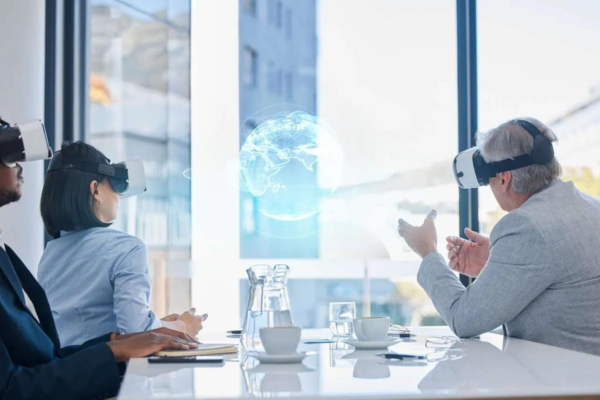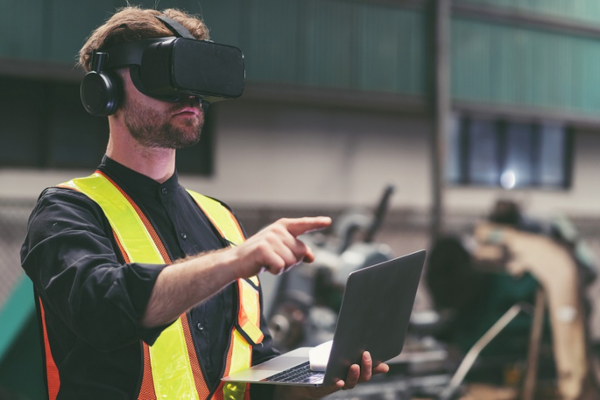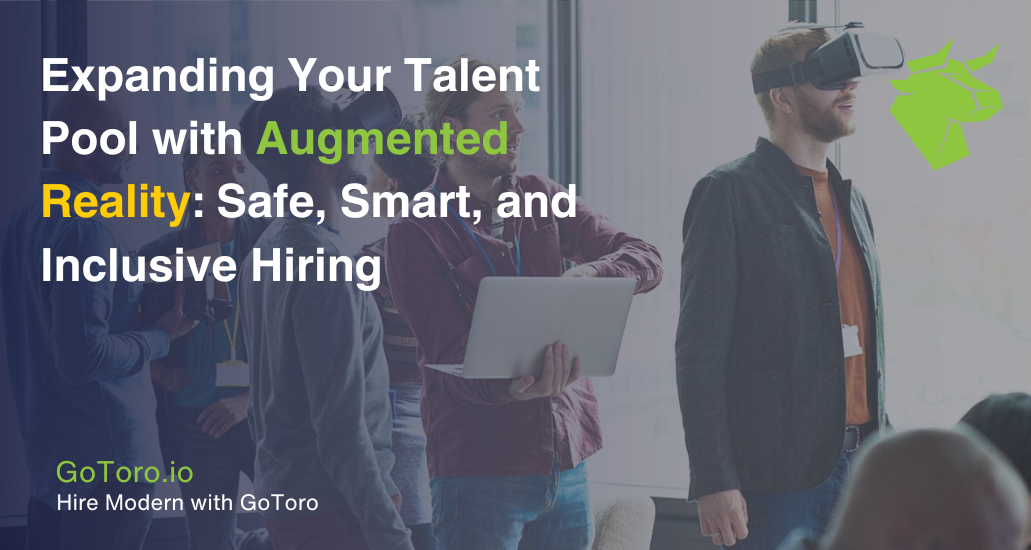As technology continues to reshape the recruitment landscape, companies are turning to innovative solutions to enhance their hiring processes. One such innovation is augmented reality in recruitment, which is transforming not only training but also how businesses assess, onboard, and engage talent. By leveraging AR, companies can expand their talent pool, ensure safer training environments, and promote inclusive hiring practices. This blog explores how augmented reality is revolutionizing recruitment, with a focus on its practical applications, like remote skill assessments, to attract diverse talent.
Companies are investing more in augmented reality (AR) technology, with AR devices and services generating around $180 billion globally in 2020. This figure is projected to grow to $340 billion by 2028.
Remote Skill Assessments with Augmented Reality

Expanding the Talent Pool with Remote Skill Assessments
In today’s global job market, companies often face challenges in conducting in-person evaluations due to geographical or logistical constraints. Augmented reality in recruitment helps solve this by enabling remote skill assessments. Candidates can participate in interactive, AR-based assessments from their own locations, allowing employers to evaluate their abilities in real-time. This method not only widens the talent pool by eliminating the need for travel but also allows companies to reach candidates from diverse regions, creating a more accessible and inclusive recruitment process.
Virtual Job Previews with Augmented Reality in Recruitment
Immersive Virtual Job Previews for Better Candidate Insight
One challenge that many candidates face is uncertainty about the work environment or role before committing to a position. Augmented reality in recruitment addresses this issue by offering virtual job previews. Through AR, candidates can explore the workplace and experience their potential roles remotely, gaining a realistic feel for the environment and job responsibilities. This immersive experience helps reduce hesitation, allowing candidates to make more informed decisions without concerns about job or location uncertainty, ultimately improving recruitment outcomes.
Enhanced Candidate Engagement with Augmented Reality
Engaging Tech-Savvy Talent with AR Experiences
In an increasingly competitive job market, attracting tech-savvy candidates who value innovation is key to staying ahead. Augmented reality in recruitment enhances candidate engagement by incorporating interactive elements into the hiring process. AR can be used for virtual office tours, job simulations, or even gamified application processes, offering an engaging and forward-thinking experience. This not only helps capture the attention of top talent but also positions the company as an innovator in the industry, making it more attractive to high-quality candidates.
Diverse Workforce Inclusion with Augmented Reality
Promoting Inclusivity Through Accessible Recruitment Solutions
Augmented reality in recruitment is playing a vital role in expanding opportunities for candidates with disabilities who may face challenges with traditional hiring processes. By utilizing AR, companies can create accessible and customizable interfaces that allow candidates to demonstrate their skills in ways that suit their unique needs. This not only opens doors for a more diverse range of candidates but also promotes a more inclusive recruitment process, helping organizations attract talent that may have been overlooked in conventional methods.
Global Talent Onboarding with Augmented Reality in Recruitment
Streamlining Onboarding for International Hires
For companies hiring globally, onboarding new talent can present logistical challenges, especially when new employees cannot immediately relocate. Augmented reality in recruitment solves this issue by offering a virtual onboarding experience. Through AR, international hires can remotely tour the office, meet their new team members, and begin training—all without having to physically be on-site. This reduces both relocation time and associated costs, ensuring a smoother, more efficient transition for global talent.
Cross-Skilling and Upskilling with Augmented Reality in Recruitment

Filling Skill Gaps by Upskilling Through AR
Organizations often look to upskill their current workforce to fill critical roles internally, reducing the need for external hiring. Augmented reality in recruitment and training offers a dynamic solution for this. By providing hands-on, real-time training through AR, employees can learn and apply new skills in immersive environments. This not only helps companies address skill gaps internally but also ensures that employees are better prepared for evolving roles, boosting retention and minimizing the need for external recruitment.
Real-Time Collaboration with Augmented Reality
Breaking Geographical Barriers with AR-Enabled Collaboration
As teams become more geographically dispersed, facilitating seamless collaboration across locations becomes crucial. Augmented reality in recruitment can extend beyond hiring to support real-time collaboration among team members. AR creates virtual spaces where employees from different locations can interact with each other and digital content, working together on projects as if they were in the same room. This capability breaks down geographical barriers, allowing businesses to tap into global talent and collaborate effectively across borders.
Enhanced Safety in Training with Augmented Reality

Improving Safety and Skill Proficiency Through AR
In industries like construction, manufacturing, and emergency services, employee safety during training is paramount. Augmented reality in recruitment offers a game-changing solution by simulating hazardous environments where employees can practice high-risk tasks without exposure to real-world dangers. Through AR, employees receive hands-on, immersive training in a safe, controlled environment. This not only improves their proficiency in handling risky tasks but also heightens their safety awareness, leading to fewer on-the-job accidents and better preparedness for real-life scenarios.
Benefits of Leveraging Augmented Reality to Expand Your Talent Pool
Access to a Broader Range of Candidates
One of the primary advantages of augmented reality in recruitment is its ability to broaden your talent pool. By using AR for remote assessments, companies can recruit candidates from remote or underrepresented areas who might not have been accessible through traditional recruitment methods.
Cost-Effective Recruitment
Augmented reality in recruitment significantly reduces the need for travel and physical assessments. This allows companies to allocate their recruitment budget more efficiently, lowering overall costs while still reaching a diverse group of candidates.
Improved Candidate Experience
AR creates an engaging, innovative recruitment process that resonates with today’s tech-savvy job seekers. By offering immersive experiences like virtual office tours or job simulations, augmented reality in recruitment enhances the candidate experience and increases the likelihood of attracting top-tier talent.
Faster Onboarding and Training
Augmented reality accelerates onboarding by providing new hires with immediate access to immersive training experiences. This reduces the time it takes for employees to become productive, ensuring a smoother transition into their roles.
Enhanced Safety in Skill Training
One of the most crucial benefits of AR is its ability to improve safety in training. By allowing employees to practice high-risk tasks in a safe environment, AR minimizes job-site accidents and enhances the overall training experience, ensuring employees are well-prepared for their roles.
Challenges of Using Augmented Reality in Recruitment

While the benefits of augmented reality in recruitment are promising, it’s essential to acknowledge the potential challenges companies might face when adopting this technology. Addressing these concerns provides a more balanced view and helps employers make informed decisions about AR implementation.
Initial Investment Costs
One of the primary challenges of integrating augmented reality in recruitment is the initial investment required. AR technology often involves significant upfront costs for hardware, software, and the infrastructure needed to run AR applications. For smaller companies or those with limited budgets, these expenses can be a barrier to entry. The return on investment (ROI) may not be immediately apparent, making it harder for organizations to justify the expenditure, especially when compared to more traditional recruitment methods.
Learning Curve for Employers and Candidates
Both recruiters and candidates will need time to adjust to using AR in recruitment. Implementing this technology requires training and adaptation for hiring teams, which can be time-consuming. Likewise, candidates unfamiliar with AR may experience a learning curve, potentially slowing down the recruitment process. Ensuring that everyone involved is comfortable with the technology is essential to maximizing its effectiveness, but this can take time and effort.
Accessibility and Inclusivity Concerns
Despite its innovative nature, augmented reality in recruitment may create unintentional barriers for certain candidates. Access to AR technology requires specific devices or internet bandwidth, which not all candidates may possess. This could limit the diversity of the talent pool, particularly for candidates in remote or under-resourced areas. Ensuring that AR tools are accessible to all candidates, regardless of their technological capabilities, is crucial to maintaining an inclusive recruitment process.
Integration with Existing Recruitment Processes
Integrating AR into existing recruitment workflows can be complex. Most companies already have established recruitment systems, and introducing AR may require significant adjustments or overhauls to these processes. From aligning AR tools with existing HR software to training staff on how to incorporate AR into their daily tasks, the implementation of this technology can be time-consuming and require detailed planning.
Data Privacy and Security Risks
Using augmented reality in recruitment involves handling sensitive candidate data. As with any digital platform, there are risks associated with data privacy and security. Companies need to ensure that the AR tools they use are compliant with data protection regulations and have robust security measures in place. Failing to do so could expose both the employer and candidates to potential data breaches or privacy violations.
How Augmented Reality in Recruitment is Transforming the Hiring Landscape
Augmented reality is revolutionizing the way companies attract, assess, and onboard talent by making the hiring process safer, smarter, and more inclusive. AR enables businesses to widen their talent pool by reaching remote and underrepresented candidates, while also offering innovative ways to assess and engage with potential hires. Additionally, AR enhances safety during training by creating immersive simulations, reducing risks in high-stakes industries.
By integrating augmented reality into their recruitment strategies, companies can not only improve the candidate experience but also reduce costs associated with travel, onboarding, and training. As the job market continues to evolve, embracing AR technology is key to staying competitive and appealing to a broader, more diverse workforce.
Ready to see how AR can transform your recruitment process? Request a demo from GoToro today and discover the future of hiring.


